Broadcasting Media and Changes
Prepare an individual essay on change within the business of sport and broadcasting in the Australian sport industry, with a focus on background, theoretical base, and practical implications for stakeholders, organizations, or the wider industry.
21 Pages5891 Words257 Views
Added on 2022-11-29
About This Document
This paper provides a brief history of broadcasting sporting events and explores how advancements in technology have shaped the industry. It discusses the implications of broadcast models for new/digital media consumption and the background of the sports and broadcasting industry. The role of OTT and internet in shaping sports broadcasting is also examined, along with solutions to consumer dissatisfaction.
Broadcasting Media and Changes
Prepare an individual essay on change within the business of sport and broadcasting in the Australian sport industry, with a focus on background, theoretical base, and practical implications for stakeholders, organizations, or the wider industry.
Added on 2022-11-29
ShareRelated Documents
Running Head: BROADCASTING MEDIA AND CHANGES
BROADCASTING MEDIA AND CHANGES
Name of the Student
Name of the University
Author Note
BROADCASTING MEDIA AND CHANGES
Name of the Student
Name of the University
Author Note
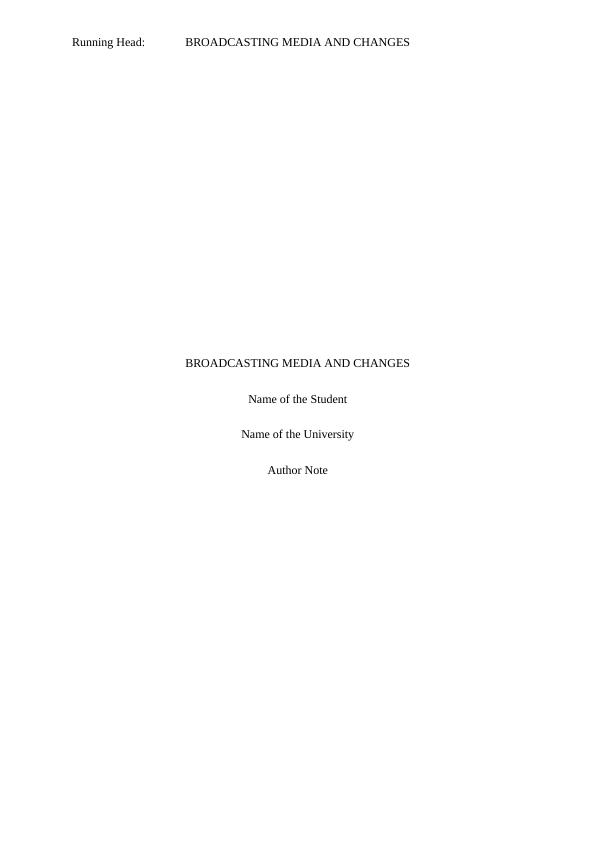
BROADCASTING MEDIA AND CHANGES1
Executive Summary
The aim of this paper is firstly o provide a brief idea about the history of broadcasting
sporting events. Here, it will state the birth of the first broadcasting and how advancement in
technology has shaped the industry. The Implications of broadcast models for new/digital
media consumption has been used in the paper such as the consumer escalation model and the
customer engagement framework. Further, it will provide the background of the sports and
broadcasting supported by a well-developed theoretical base focusing on the Australian
sports industry through implication for the stakeholders and organizations in the sports
industry.
Executive Summary
The aim of this paper is firstly o provide a brief idea about the history of broadcasting
sporting events. Here, it will state the birth of the first broadcasting and how advancement in
technology has shaped the industry. The Implications of broadcast models for new/digital
media consumption has been used in the paper such as the consumer escalation model and the
customer engagement framework. Further, it will provide the background of the sports and
broadcasting supported by a well-developed theoretical base focusing on the Australian
sports industry through implication for the stakeholders and organizations in the sports
industry.
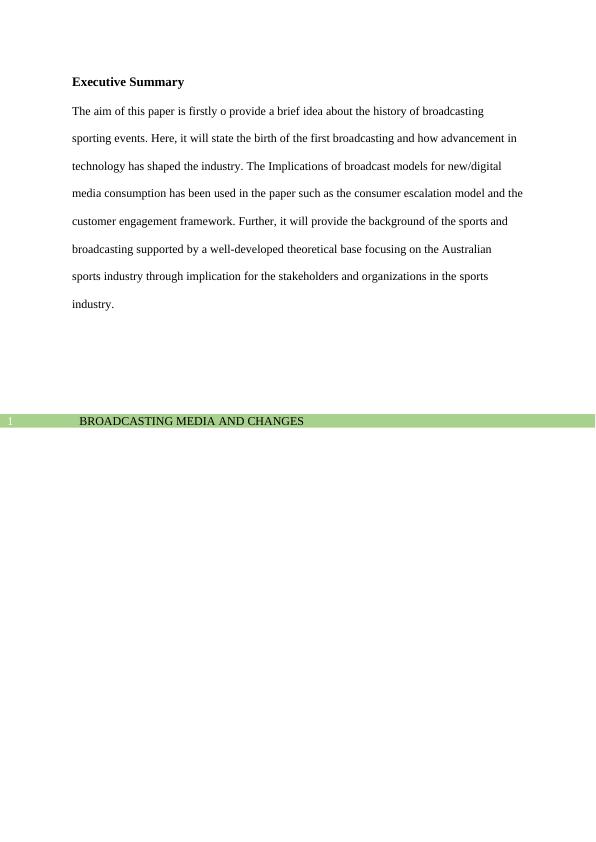
BROADCASTING MEDIA AND CHANGES2
Table of Contents
Introduction................................................................................................................................3
Discussion:.................................................................................................................................3
Company Background............................................................................................................3
Strategic Analysis: Porter’s 5 Forces.....................................................................................5
Strategic Analysis: PESTEL Analysis...................................................................................6
Derived SWOT Analysis........................................................................................................8
Conclusion:................................................................................................................................8
References............................................................................................................................10
Table of Contents
Introduction................................................................................................................................3
Discussion:.................................................................................................................................3
Company Background............................................................................................................3
Strategic Analysis: Porter’s 5 Forces.....................................................................................5
Strategic Analysis: PESTEL Analysis...................................................................................6
Derived SWOT Analysis........................................................................................................8
Conclusion:................................................................................................................................8
References............................................................................................................................10
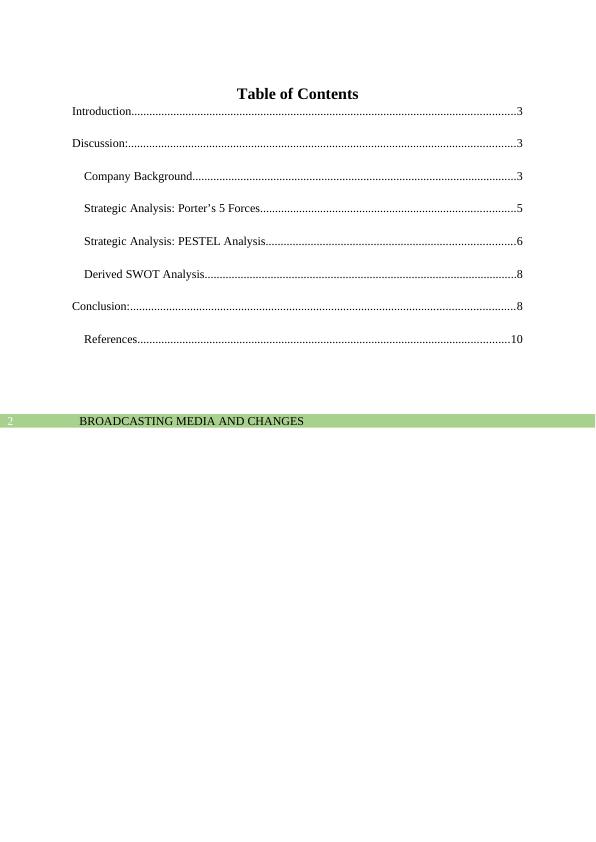
BROADCASTING MEDIA AND CHANGES3
Background
Digital media is transforming the society and the perception of the people to access
information over the years. Unlike the broadcast media, digital media provides more
authority to the consumers and unleashes the limited range fed by the broadcast media. One
of the biggest sector in the entertainment and information sector is the sports industry. Sports
is one of the most essential part of the entertainment industry and most of the viewers are
present in the broadcasting and social media due to the presence of sports in the medium.
With advancement in technology, the mediums of passing down sports information is
changing over time. Earlier live broadcasting was done through radio where the masses only
heard the commentary of the ongoing activities. Later it became video based transfer of
information which still dominates the broadcasting industry. As the medium is viewed by the
masses and the choice of view does not fully depend on the viewers, it is restricted by the
government on the range of content it provides. The television broadcasting media is still the
most dominating among all mediums and enjoys maximum number of footfalls (Owens
2015). On the other hand, after the advent of the internet, the consumers are shifting away
from the conventional medium towards the digital medium. The sports industry was quick to
realise that the future of broadcast media is digitization. The digital media can be categorized
under the narrowcast media as the streaming is restricted to the subscribers and the content
gives the freedom to the viewers to choose according to their preferences. The shift of
paradigm of the sports industry into the digital media has proven to be useful as the
consumers are more attached to their laptops and smartphones more than the conventional
media i.e. television. On the other hand, with the improvement in technology and speed of the
internet, it makes it easier for the narrowcast industry to live stream the events especially
sports which attracts the maximum number of footfalls. The companies are quick to realise
that the future of the sports industry will be focused on the narrow stream media due to the
Background
Digital media is transforming the society and the perception of the people to access
information over the years. Unlike the broadcast media, digital media provides more
authority to the consumers and unleashes the limited range fed by the broadcast media. One
of the biggest sector in the entertainment and information sector is the sports industry. Sports
is one of the most essential part of the entertainment industry and most of the viewers are
present in the broadcasting and social media due to the presence of sports in the medium.
With advancement in technology, the mediums of passing down sports information is
changing over time. Earlier live broadcasting was done through radio where the masses only
heard the commentary of the ongoing activities. Later it became video based transfer of
information which still dominates the broadcasting industry. As the medium is viewed by the
masses and the choice of view does not fully depend on the viewers, it is restricted by the
government on the range of content it provides. The television broadcasting media is still the
most dominating among all mediums and enjoys maximum number of footfalls (Owens
2015). On the other hand, after the advent of the internet, the consumers are shifting away
from the conventional medium towards the digital medium. The sports industry was quick to
realise that the future of broadcast media is digitization. The digital media can be categorized
under the narrowcast media as the streaming is restricted to the subscribers and the content
gives the freedom to the viewers to choose according to their preferences. The shift of
paradigm of the sports industry into the digital media has proven to be useful as the
consumers are more attached to their laptops and smartphones more than the conventional
media i.e. television. On the other hand, with the improvement in technology and speed of the
internet, it makes it easier for the narrowcast industry to live stream the events especially
sports which attracts the maximum number of footfalls. The companies are quick to realise
that the future of the sports industry will be focused on the narrow stream media due to the
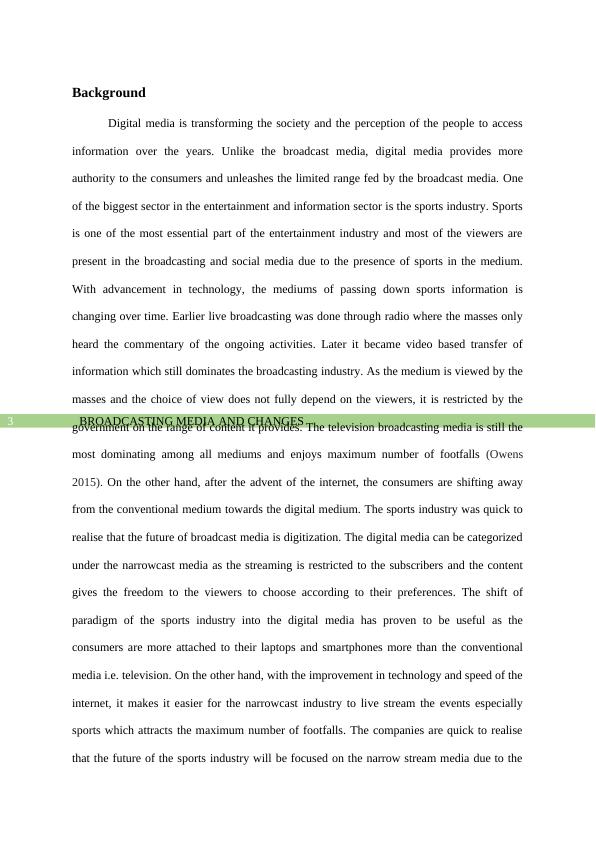
BROADCASTING MEDIA AND CHANGES4
above stated reasons. The stream operates in a very flat revenue structure which is mainly
based on the subscription model payable on a monthly, quarterly or annual basis. The
customer is provided with an accessing portal where the user has to create a virtual account
through which the user can access the services.
History of Broadcasting
The history of sports broadcasting was initiated in Lawrence, Kansas when in a one
fine evening thousands of people came to the stadium to watch a football game which was
held between Kansas football team and Missouri football team in the year 1911. The
associated body of the Western Union used telegram as the mode to broadcast the game in
Missouri, Columbia, and the place where the football match was being held. The details of
the sport was sent the next day to Kansas via telegram. This was the introduction of
broadcasting and its birthplace was in Missouri.
The first time when voice was used as the medium to broadcast was through radio
and took place in the year 1921 at the Westinghouse station in Pittsburgh. The first sport
involved was boxing. A full ten round match was broadcasted for the first time in the history
of broadcasting and radio. A few months later, the sport to be broadcasted was baseball. The
match was held between Philadelphia Phillies and Pittsburgh Pirates at Forbes Field. Later
broadcasting through radio became very popular and even broadcasted College football
matches. Understanding the increasing popularity most of the baseball teams started their
own broadcasting held live via radio (Be On Air, 2019).
Live broadcasting was initiated on 17th May, 1939 in the United States of America.
The first sport to be broadcasted live was baseball. The match was held between two college
teams Princeton Lions and Colombia tigers. The broadcasting body associated with the game
above stated reasons. The stream operates in a very flat revenue structure which is mainly
based on the subscription model payable on a monthly, quarterly or annual basis. The
customer is provided with an accessing portal where the user has to create a virtual account
through which the user can access the services.
History of Broadcasting
The history of sports broadcasting was initiated in Lawrence, Kansas when in a one
fine evening thousands of people came to the stadium to watch a football game which was
held between Kansas football team and Missouri football team in the year 1911. The
associated body of the Western Union used telegram as the mode to broadcast the game in
Missouri, Columbia, and the place where the football match was being held. The details of
the sport was sent the next day to Kansas via telegram. This was the introduction of
broadcasting and its birthplace was in Missouri.
The first time when voice was used as the medium to broadcast was through radio
and took place in the year 1921 at the Westinghouse station in Pittsburgh. The first sport
involved was boxing. A full ten round match was broadcasted for the first time in the history
of broadcasting and radio. A few months later, the sport to be broadcasted was baseball. The
match was held between Philadelphia Phillies and Pittsburgh Pirates at Forbes Field. Later
broadcasting through radio became very popular and even broadcasted College football
matches. Understanding the increasing popularity most of the baseball teams started their
own broadcasting held live via radio (Be On Air, 2019).
Live broadcasting was initiated on 17th May, 1939 in the United States of America.
The first sport to be broadcasted live was baseball. The match was held between two college
teams Princeton Lions and Colombia tigers. The broadcasting body associated with the game

BROADCASTING MEDIA AND CHANGES5
was NBC. This though was not the first event to be broadcasted live via television. In the
year 1936, the event broadcasted live over television was the Berlin Summer Olympics but
was limited to certain parts of Germany. Due to the limitation of technology, live
broadcasting could not be done beyond a certain range. The first live broadcasting event via
television throughout the country was held on 29th September, 1951. The game was held
between Duke University and the Pittsburgh University. Later due to the issue of
broadcasting rights were under controversy and broadcasting college teams was banned.
Again in the year 1982 the rule was changed and broadcasting live matches started. Later
football match broadcasting became very popular and became a part of the daily life of the
viewers.
Broadcasting Professional Sports event was initiated in the year 1939 and the sports
involved was basketball. Professional events exponentially became famous and surpassed the
popularity of college sports events. This was the year when the full NFL championship was
broadcasted through radio transmitters. The NFL championship from the year on became
famous and continued to become more popular among the viewers. Now, the event has
gained so much popularity, it has become a prime market to advertise various brands. The net
revenue earned by the tournament through broadcasting rights was more than 5 million
dollars per year in the 1960’s (Sports Television Broadcasting, 2019). Later due to the clash
between the broadcasting rights between private companies ruined the whole scenario and the
game became infamous over the years.
Role of OTT
It has been observed that the people are shifting away from traditional media towards
narrowcast media. After the advent of social networking websites such as Facebook,
Instagram, Twitter and so on, the preference of attaining information was through laptops,
computers and smartphones. And due to the improvement of technology, the importance of
was NBC. This though was not the first event to be broadcasted live via television. In the
year 1936, the event broadcasted live over television was the Berlin Summer Olympics but
was limited to certain parts of Germany. Due to the limitation of technology, live
broadcasting could not be done beyond a certain range. The first live broadcasting event via
television throughout the country was held on 29th September, 1951. The game was held
between Duke University and the Pittsburgh University. Later due to the issue of
broadcasting rights were under controversy and broadcasting college teams was banned.
Again in the year 1982 the rule was changed and broadcasting live matches started. Later
football match broadcasting became very popular and became a part of the daily life of the
viewers.
Broadcasting Professional Sports event was initiated in the year 1939 and the sports
involved was basketball. Professional events exponentially became famous and surpassed the
popularity of college sports events. This was the year when the full NFL championship was
broadcasted through radio transmitters. The NFL championship from the year on became
famous and continued to become more popular among the viewers. Now, the event has
gained so much popularity, it has become a prime market to advertise various brands. The net
revenue earned by the tournament through broadcasting rights was more than 5 million
dollars per year in the 1960’s (Sports Television Broadcasting, 2019). Later due to the clash
between the broadcasting rights between private companies ruined the whole scenario and the
game became infamous over the years.
Role of OTT
It has been observed that the people are shifting away from traditional media towards
narrowcast media. After the advent of social networking websites such as Facebook,
Instagram, Twitter and so on, the preference of attaining information was through laptops,
computers and smartphones. And due to the improvement of technology, the importance of
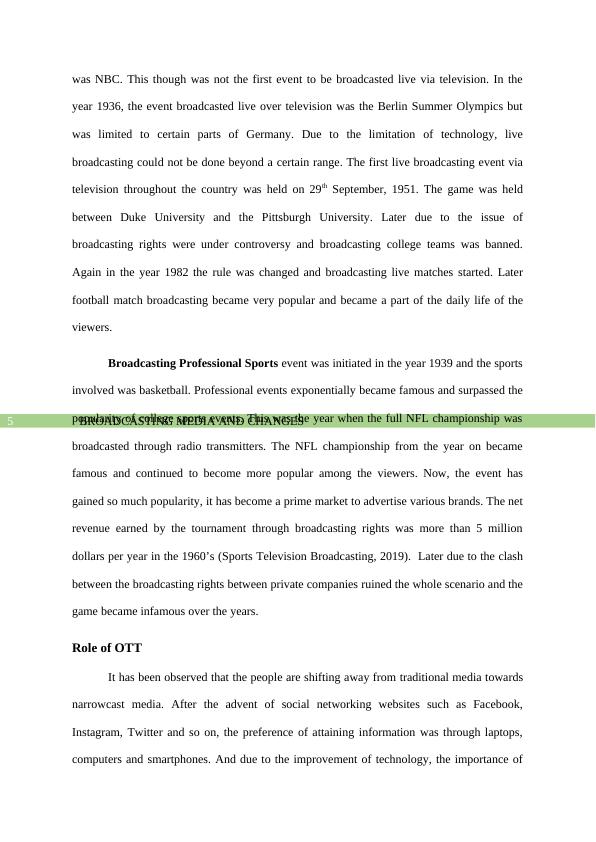
End of preview
Want to access all the pages? Upload your documents or become a member.
Related Documents
Organisational Structure and Strategies of BBClg...
|12
|3808
|3
Understanding Audience: Changes in Contemporary Television Industrylg...
|18
|4041
|428
